Water is essential for life and there are many situations where clean water is not available. If you’re lucky, you can last maybe 3 – 5 days without water. If you loose 10% of your bodily fluid you are at risk of death.
Some interesting facts about how much water we actually need, as these may be useful to know in a survival situation were water is limited:
You loose just over 2 pints of water per day through normal bodily functions and according to research by the Pacific Institute of Studies can loose up to 10 pints per day in very hot climates. The amount needed per person, per day, depends on:
- An individual’s weight
- The environment temperature
- The amount of activity
- If you’re pregnant you need more water
- There may also be a relationship between the amount needed based on a fat/muscle ratio
The report carried out by the Pacific Institute of Studies also looked at what the minimum requirements of water needed by an individual were – you can see this in the table below. However, other sources quote amounts around 3.5 pints per day. The table below is in liters, to convert 1 liter is around 1.75 pints.
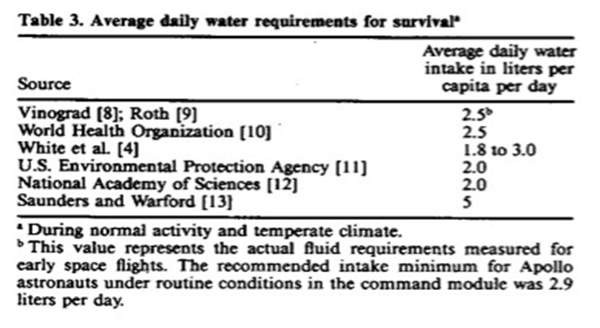
General Advice
But before I begin, some general advise:
- Use your stored water for drinking purposes only –thirsty trumps dirty and smelly, but do keep wounds clean
- Containers made of a plastic known as polyethylene terephthalate, or PET can leach chemicals including the heavy metal, antimony, into water, so try and avoid containers made of PET
- Use containers that are clean – any organic matter can contaminate water and bacteria and viruses can make the water toxic
- Use water purification tablets or powder to keep stored water clean
- Other chemicals like fertilizers present in a container can cause algae to grow in the water
- You’ll probably have heard about filling the bathtub up with water when the SHTF. This is fine to do, as long as you remember the water isn’t likely to stay clean and is for short term use only (see waterBOB below)
- How much water to store is up for debate and ultimately will be your decision, but plan for at least two weeks worth of need on a per person basis
- Bear in mind that if certain war events have taken place rain may be contaminated and unsuitable for drinking. This is also true for river and stream water.
Storing Water
Commercial Bottled Water
If you have time to think about it beforehand, you can stock up on bottled water. The Department of Homeland Security recommends that you store at least 1 gallon of water per person, per day, for 3 days. The International Bottled Water Association say about storing bottled water, that it should be stored at room temperature or cooler and away from direct sunlight and chemicals. This is because at warmer temperatures algae can form in the water and that the plastic of a water bottle is permeable and can allow chemicals to seep into the water. The FDA don’t require an expiration date for bottled water, but the state of New Jersey do set a 2 year limit on bottled water.
Rain Barrels
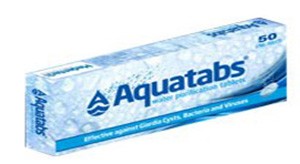 You can store water in rain barrels by filling them from the cold-water tap. You can buy 60 gallon barrels for the purpose and keep these ready to go. The barrels MUST be very clean before you use them. Also you really should use some sort of sterilizing chemical to prevent algae and bacteria from contaminating the stored water. You can buy purification tablets or powder, like Aquatabs online from Amazon.
You can store water in rain barrels by filling them from the cold-water tap. You can buy 60 gallon barrels for the purpose and keep these ready to go. The barrels MUST be very clean before you use them. Also you really should use some sort of sterilizing chemical to prevent algae and bacteria from contaminating the stored water. You can buy purification tablets or powder, like Aquatabs online from Amazon.
And of course, you can use the barrels to collect and store rainwater too, assuming the rain is not contaminated.
Specialist Water Tanks
You can buy large, up to 15,000 gallon, water tanks to prepare for when the SHTF. As with the smaller rain barrels you will have to use purification chemicals to make sure the water stays clean and drinkable.
Water Balloon Storage: The waterBOB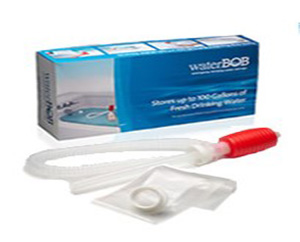
There is a product called the waterBOB, which is an FDA approved plastic balloon, which can be filled direct from your faucet, aka your bathtub, and which keeps water clean for up to 16 weeks. It also can hold up to 100 gallons of water. If you place this in the tub and fill it up, it resolves the issue of keeping the water clean.
Alternative Water Systems
Of course you might not be able to fill up the waterBOB or have access to bottled water, so you’ll need to collect it.
Creeks and Fresh Water Rivers
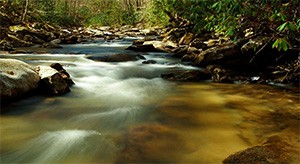
You can drink water from a non-salt source like a fresh water river or a creek. However, you do have to be careful and sensible. I was taught to look up stream and if there was any evidence of a dead animal or any contamination, then don’t drink it.
You can of course sterilize the water. You can boil it, which gets rid of bacteria, protozoa (like cryptosporidium) and most viruses.
Rain Water
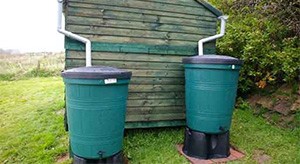
You can collect rainwater using a simple system, like the one in the photo above, where guttering on a small shed or similar is used to pass collected rainwater into a rain barrel. Use some sort of filter at the end of the pipe to stop debris entering the barrel – be sure to clean this out regularly as it gets filled with leaves.
There are commercial rainwater collection systems that you can use too. Companies like RainHarvest Systems provide home based collection systems that can harvest up to 15,000 gallons of rainwater.
Which ever way you collect the rainwater, you need to be wary of any potential contaminants in the rain, including radioactivity and acidity. Drinking something in is a great way to get toxins into your body. If it’s nuclear don’t drink it, period. If its acidic, you can treat it with an alkaline solution like sodium carbonate, but you need to test the acidity with an indicator of some kind to make sure you get the balance right.
It is also wise to sterilize the rainwater you collect.
Top 10 Vehicles for Your EMP Survival
This Bug Will Kill Most of the Americans during the Next Crisis (Video)
Waterproof Socks – One Step Further In Terms of Outdoors Living

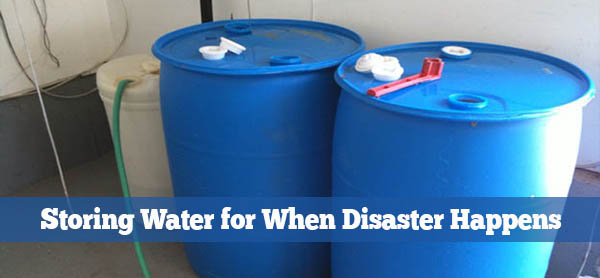





















Save plastic bottles used in commercial bottled water. Refill with fresh water from sources such a clear running stream, rain water or any source without toxic elements. Place filled bottles on a reflected surface in bright sunlight for 10 hours. The Sun’s UV Rays will sterilize the water for drinking. Bottles can be cleaned and reused.
This is a great way to store your water. I remove the Labels from my 32 oz. Gatorade bottles, store them in the sun and the results equals in taste to spring water. Wash the bottles, fill with water and put them back out for re-use. For my BOB I use the 20 oz., much easier to carry in the pockets. Live long and plan ahead!
The water storage method you mention should work great but with some cautions taken. Choose bottles by the type of plastic used as most leech chemicals into the water stored. Avoid the ones with 3 or 7 in the recycle symbol. Also, while water can be treated to be drinkable in a day’s worth of UV from the sun, storing it that way may promote alae growth in the long term.
Don’t forget having on hand the means of filtering, purifying, and/or treating water in addition to keeping a stored supply.
This is mostly for water stored at home not transported to and fro. I have a bartender friend who saves quart liquor bottles for me. I soat the labels off and fill with water. I don’t think that glass will leach anything into the water and they should be sterilized. Mike
For years, my wife and I have been using empty bleach bottles. When the product is gone, I simply fill them without washing them out….reg bleach ONLY! I have drank water that was over 15 years old from these! Little flat, no smell or bad taste, and shaking made the water good! The containers were stored in s dark, cool if not very cold (frequently freezing) shipping container, and the plastic showed no ill effects from the years! Still use this method.
I’ve heard that from a friend as well. But, do you still have to use water purifier tabs or no? Is the residual bleach enough to purify? Even after 15 yrs?
That’s a great idea. Bleach kills anything! I have been cutting them into grain scoops but now I will used them for water storage. Thanks so much for the tip!
For sun sterilization of water, use no larger than 2 liter bottles. The water must be clear. Cloudy water requires longer sunlight exposure. The bottles also must be clear without labels or other impediment to sunlight penetrating the bottle. When in doubt, use more sunlight exposure.
You could fill the washing machine with water and gain about 40 gallons plus the bathtub water and water heater volumn would give you a quick start. But turn off the water when the water service can’t produce clean water.
Granny A:
Great suggestion about the washing machine for water storage. It hadn’t occurred to me. You are absolutely correct. That is a great water storage facility. I would only fill it with the cold water tap turned on. That way if the water supply should die part way through filling, the water heater would still be full.
Same thing with the BOB water storage device. Only fill it with the cold water tap to preserve any water that is in your hot water heater.
Used IBCs (Industrial Bulk Containers) can be found at Farm Supplys. They hold around 300 gallons and priced pretty inexpensively. They can be washed out of former contents (usually fertilizers, or juices. Plans are available to convert them to hydroponic setups as well.